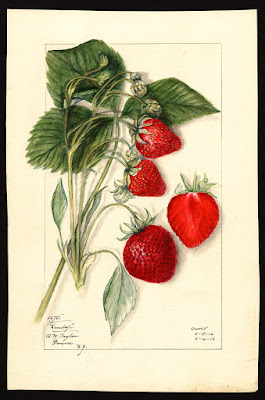Long before ecofeminism was an idea, these women produced clear-eyed, scientific observations of nature.
 |
|
Cerise de Montmorency cherry (Prunus avium), with specimen originating in Linden, Maryland; 1910, watercolor by Deborah Griscom Passmore, courtesy USDA
|
I would never know about the US Department of Agriculture’s Pomological Watercolor Collection if it weren’t for an artist and activist named Parker Higgins. Starting around 2015, he began investigating why the USDA kept their digitized collection behind a paywall. He found that the USDA had miscalculated when entering the rough-and-tumble market of digital data, spending $300,000 to earn just $600 in fees. He then pushed public officials to release the pictures to the public for free.
The watercolors would have remained unknown, except that Higgins then taught himself to program enough to build a twitter bot. Follow @pomological, and you can see a new Old Fruit Picture every three hours.
 |
|
Diseased Lisbon lemon (Citrus limon); 1910, watercolor by Elsie Lower Pomeroy, courtesy USDA
|
The USDA’s Pomological Collection was cutting edge long before Higgins took it up. At a time when women were barely represented in the workforce, they were the driving force behind this work.
Women were just beginning to attend art school in the latter half of the 19th century. For most of them, a career like Mary Cassatt’s was out of the question. Working as a government illustrator was an acceptable career choice. About a third of the USDA’s pomological artists were women, and just three of them were responsible for more than half the collection: Deborah Griscom Passmore, Amanda Almira Newton, and Mary Daisy Arnold.
 |
|
Japanese persimmon (variety Hachiya); 1915, watercolor by Amanda Newton, courtesy USDA
|
The paintings were mostly produced in the thirty-year span from 1886 to 1916. They were intended for use as illustrations in USDA publications directed toward farmers. This was a time of high immigration and rapid growth westward; ten states joined the Union in that thirty-year period. Rapidly-expanding agriculture went along with rapidly-expanding population. The hunt was on for fruits that could endure shipping, and farmers worked with the USDA to test and then grow these cultivars. The artists were sent samples of these fruits from farmers across the nation. They then made scientifically-accurate illustrations for USDA publications and records. The majority of these cultivars no longer exist.
Deborah Griscom Passmore was the daughter of a Quaker farmer from Delaware County, PA. She studied at the Pennsylvania Academy of Fine Arts and then went on to Europe. Passmore was hired by the USDA in 1892, and her talents were quickly recognized. Within a year she was head of the department, which at the time had fifty artists attached to it. One of her first tasks was to paint exhibits for the 1893 World’s Columbian Exposition in Chicago. She worked for the USDA for 19 years, and was responsible for a fifth of its 7500 paintings.
 |
|
Dunlap variety of strawberries (Fragaria species), with specimen originating in Geneva, New York; 1912, watercolor by Mary Daisy Arnold, courtesy USDA
|
Less is known about the life of Amanda A. Newton. She was the granddaughter of Isaac Newton, the first commissioner of the USDA, who died when she was a child. She introduced the innovation of wax models of fruit to the survey, making about 300 specimens herself. Mary Daisy Arnold’s origins are similarly obscure, but she was known to have attended art school in New York. When she wasn’t painting fruit for the USDA, she painted landscapes in oils.
Elsie Lower Pomeroy was the one female USDA illustrator who went on to an independent painting practice. Born in New Castle, PA, she was raised in Washington and attended the Corcoran School of Art. She worked in the Washington USDA office, married a staff pomologist and moved with him to Riverside, CA. There, she became involved in the California Realism movement.
19th century women watercolorists have an unjust reputation for anemic, ‘maidenly’ work, but there is nothing hesitant about these watercolors. They are careful technical renderings with big, juicy color. From a time long before ecofeminism was an idea, they are clear-eyed observations of nature.

